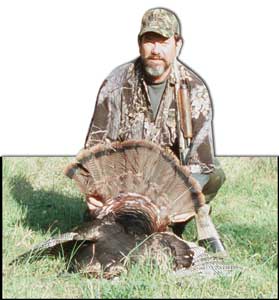
If you want to have more wild turkeys, try planting chufas, and watch your land sprout feathers.
Farmers want rain in the spring after they’ve planted their fields so seeds will sprout and eventually grow crops.
Now precipitation doesn’t grow wild turkeys, but it certainly doesn’t hurt when scouting for birds. Wet weather — but not downpours — seems to “grow” turkeys in fields during the early spring. At least that’s what happened last April during a hunting trip at Northampton County.
After passing through the town of Jackson, which is split by U.S. 158 (the shortest route, believe it or not, from central North Carolina to the Outer Banks instead of U.S. 64 East), the dashboard clock showed 5 p.m. It was cloudy and drizzling rain.
Bands of showers and black scudding clouds punctuated the two-hour drive to Northampton, not a good omen, one would think, for a long-planned turkey hunt the next day.
But as I glanced out my side window at a big, dark field beside US. 158, my mind suddenly flashed back to a southern Virginia Saturday morning some 30 years ago and a wet adventure with a veteran hunter whose mailing address was, believe it or not, Turkeycock Mountain.
The wind roared in the tree tops and the rain stung like sleet that morning. Then the front passed about 11 a.m., and the sun began to play peek-a-boo behind rapidly-moving clouds.
“Let’s ride some of the back roads and see if we can see some turkeys out in the fields,” my host said.
Sure enough, we hadn’t gone 2 miles when he said, “There’s one.”
A big Virginia Eastern tom, black with wet shiny feathers, a blood-red wattle and 11- or 12-inch beard, was strolling unconcerned near the edge of a green field.
“Let’s get him,” said the 70-ish Virginian, as he yanked his WW II-vintage Jeep off the blacktop, and we began bouncing through mud puddles pocketing a logging path at the edge of the field.
With seconds we pulled even with the gobbler, who began to sprint toward the safety of the woods at the field’s far end. We had him cut off from the forest beside him, so his only hope was to outrun us to the tree line in front of him.
“Stick your gun out the window and pop him,” my driver yelled above the roar of the Jeep’s engine.
Well, needless to say, I declined his invitation. As the outdoors editor of a local newspaper, I didn’t believe blasting turkeys from a moving Jeep was something I ought to do.
But, for just a moment there …
Last April as I drove through the misty evening rain in Northampton County, I remembered the long-ago rain-and-turkey-chasing experience because when I looked into the field in the fading light, I saw not one, but perhaps three dozen wild turkeys, feeding as carefree as yard chickens.
At the next opening beside the road, I saw more dark shapes, perhaps 50 turkeys, also nonchalantly scanning the ground for earthworms driven to the surface by the rain.
The further toward my destination I went the more wild turkeys I saw. Each field had dozens of Eastern birds, walking about in the drizzle a few minutes before time to fly to roosts for the night.
Caswell County has long been designated the top turkey haven in North Carolina, while Ashe County in the northwestern corner of the state has tremendous flocks of birds. But nothing beats Northampton County these days.
The reason? Probably chufa.
If you’re not a turkey hunter, you’re probably scratching your head. Chufa? What’s that?
The rest of this story, which first appeared in the March 2007 issue of North Carolina Sportsman, can be found in the online archives.
Be sure to subscribe to the magazine to ensure you don’t miss a single issue, which will be delivered right to your door.




Be the first to comment